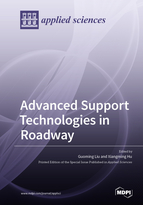Advanced Support Technologies in Roadway
A special issue of Applied Sciences (ISSN 2076-3417). This special issue belongs to the section "Civil Engineering".
Deadline for manuscript submissions: closed (20 April 2022) | Viewed by 21821
Special Issue Editors
Interests: shotcrete; coal mining; rheology; dust suppression
Special Issues, Collections and Topics in MDPI journals
Interests: material characterization; polymers; polymeric materials; materials engineering; polymer synthesis; TGA; thermogravimetric analysis; fire; polyurethane; safety engineering; fire ... engineering; flame retardants; formaldehyde; foam cells
Special Issue Information
Dear Colleagues,
In recent years, there has been rapid progress in the development and application of underground space, such as roadways, tunnels, and underground chambers. Bolt shotcrete support is one of the important means to maintain the stability and integrity of roadways. Advanced support technology (including shotcrete material, theory, and equipment) are important means to ensure the safe and efficient application of roadways. In the process of underground space development, extreme geological conditions such as high ground stress and high temperature can easily cause rock burst, high-temperature heat damage, and harmful gas outburst. There has been substantial research into support technology for roadways. For example, spraying steel fiber-reinforced concrete technology to prevent roadway cracking. A large number of research results provide theoretical and technical methods for roadway support. However, with the improvement of occupational safety and health requirements, as well as the complex geological conditions of support requirements, advanced roadway support technology is urgently needed, which must not only play a supporting role, but also be safe, efficient, and environmentally friendly. In particular, in the narrow roadway space, the process of excavation is easy to produce a high concentration of dust, causing construction workers pneumoconiosis. Reasonable support technology can reduce the displacement of surrounding rock and reduce the dust concentration in roadways. Therefore, the exchange and discussion of advanced roadway support technology are conducive to the safe and efficient development of underground space.
In this Special Issue, original research articles and reviews are welcome. Research areas may include (but are not limited to) the following: advanced cement-based materials for roadway support; advanced surrounding rock control technology; dust control methods in roadways; advanced support equipment for roadway; advanced disaster control theory for roadways.
Dr. Guoming Liu
Prof. Xiangming Hu
Guest Editors
Manuscript Submission Information
Manuscripts should be submitted online at www.mdpi.com by registering and logging in to this website. Once you are registered, click here to go to the submission form. Manuscripts can be submitted until the deadline. All submissions that pass pre-check are peer-reviewed. Accepted papers will be published continuously in the journal (as soon as accepted) and will be listed together on the special issue website. Research articles, review articles as well as short communications are invited. For planned papers, a title and short abstract (about 100 words) can be sent to the Editorial Office for announcement on this website.
Submitted manuscripts should not have been published previously, nor be under consideration for publication elsewhere (except conference proceedings papers). All manuscripts are thoroughly refereed through a single-blind peer-review process. A guide for authors and other relevant information for submission of manuscripts is available on the Instructions for Authors page. Applied Sciences is an international peer-reviewed open access semimonthly journal published by MDPI.
Please visit the Instructions for Authors page before submitting a manuscript. The Article Processing Charge (APC) for publication in this open access journal is 2400 CHF (Swiss Francs). Submitted papers should be well formatted and use good English. Authors may use MDPI's English editing service prior to publication or during author revisions.
Keywords
- roadway support
- support equipment
- cement-based material
- rock control
- dust suppression
- disaster control
- shotcrete
- fire suppression
- theory






